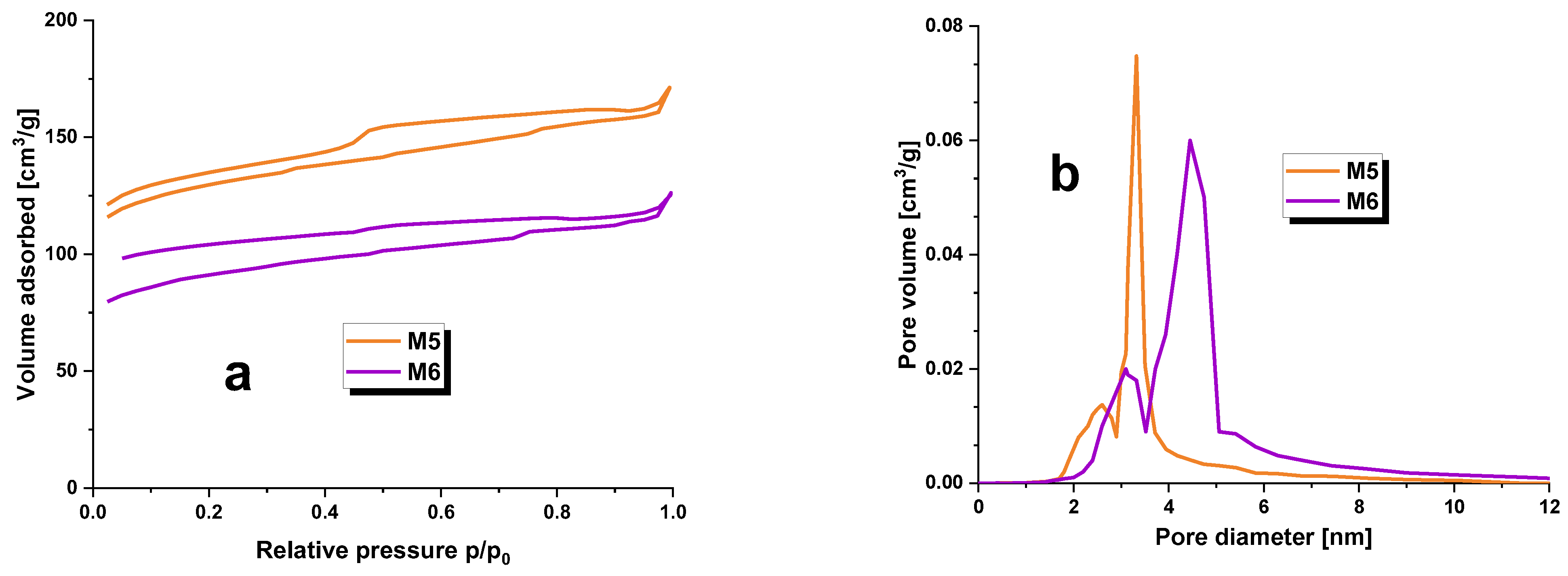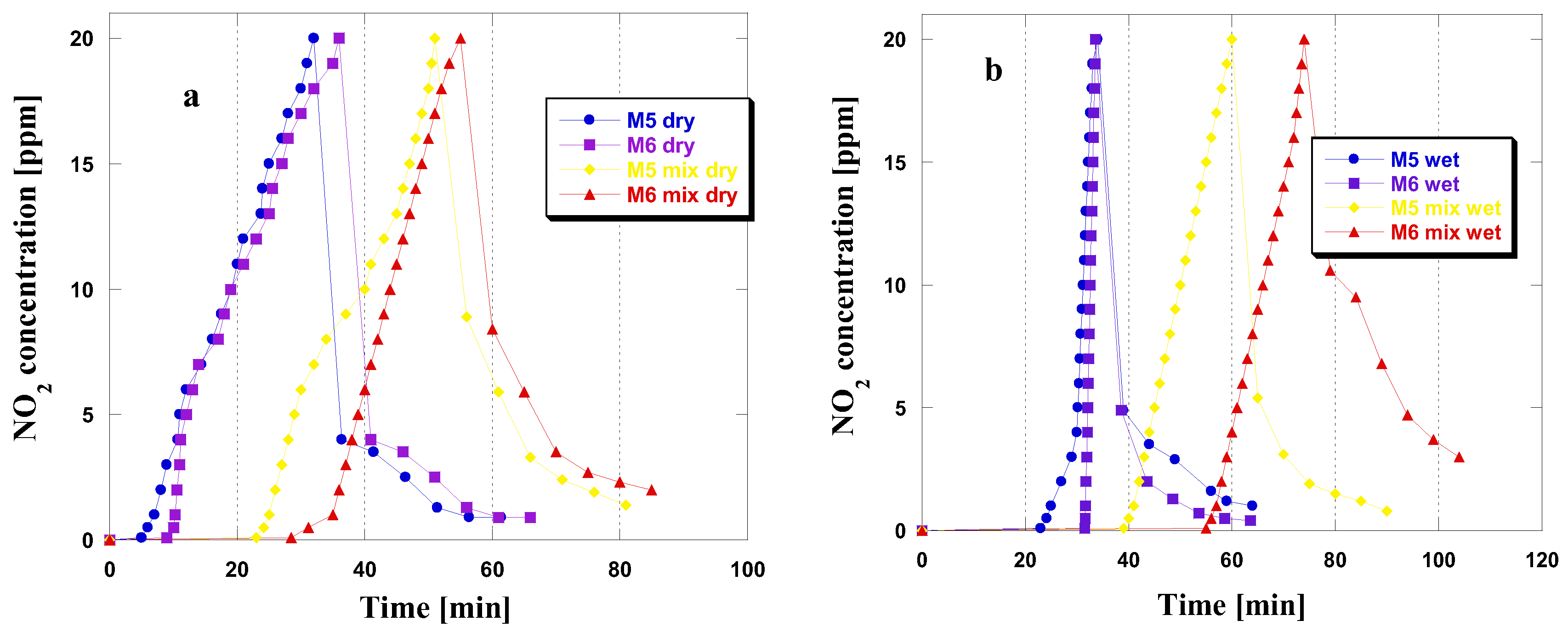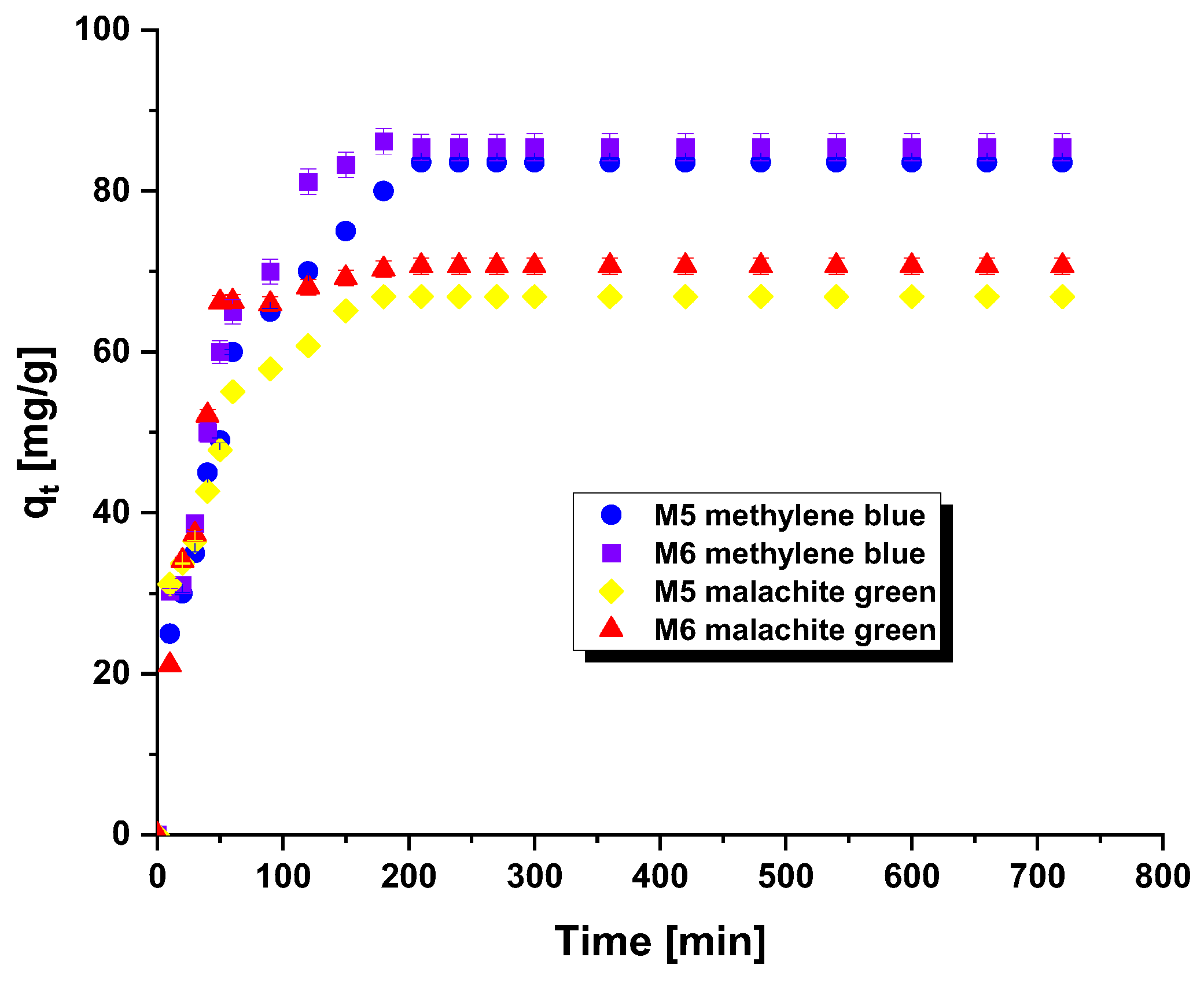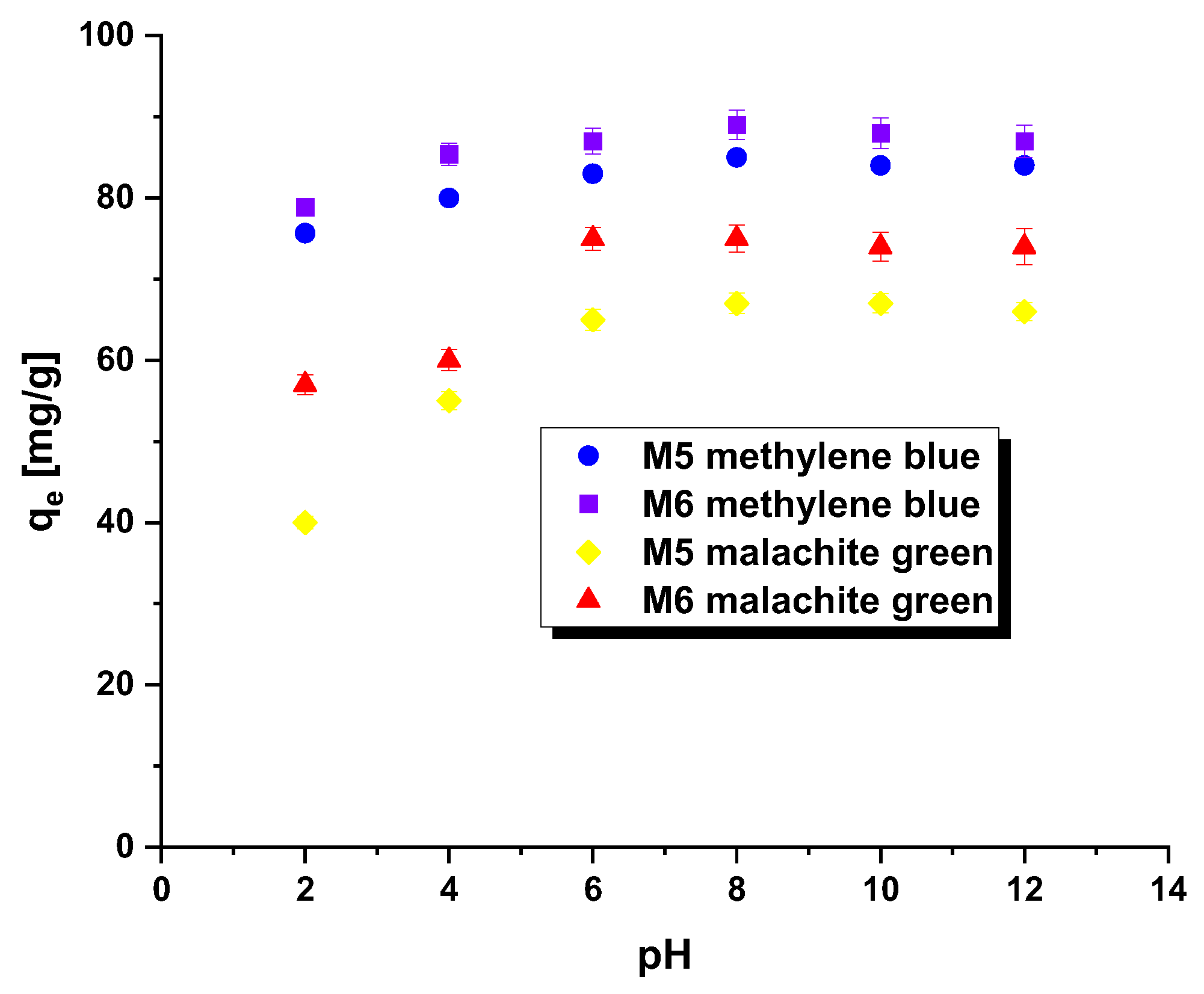Microwave Heating for Synthesis of Carbonaceous Adsorbents for Removal of Toxic Organic and Inorganic Contaminants
Abstract
:1. Introduction
2. Results and Discussion
2.1. Characterization of the Precursor and Adsorbents
2.2. Adsorption Study
3. Materials and Methods
3.1. Materials
3.2. Carbonaceous Adsorbents Characteriztaion
3.3. Preparation of Activated Carbons
3.4. Adsorption Study
4. Conclusions
- (1)
- Microwave heating enabled the pyrolysis of the raw material, producing carbonaceous materials with a surface area of 372 and 502 m2/g and a micro-mesoporous structure.
- (2)
- The synthesized carbonaceous adsorbents featured both acidic and basic groups on their surface. However, the basic groups dominated the surface character.
- (3)
- The efficacy of the developed carbonaceous adsorbents in removing nitrogen oxide(IV) has been demonstrated, despite their low specific surface area. This was especially observed when the adsorption process occurred under wet conditions and was preceded by a 30-min flushing of the adsorbent bed with moist air.
- (4)
- The efficiency of the carbonaceous adsorbents in removing organic dyes increased with the initial concentration of the dye solution. The adsorption rate followed pseudo-second order kinetics. Langmuir-type isotherms were observed in all experiments on the adsorption of methylene blue/malachite green.
Author Contributions
Funding
Institutional Review Board Statement
Informed Consent Statement
Data Availability Statement
Conflicts of Interest
Sample Availability
References
- Lu, T.; Cao, W.; Liang, H.; Deng, Y.; Zhang, Y.; Zhu, M.; Ma, W.; Xiong, R.; Huang, C. Blow-Spun Nanofibrous Membrane for Simultaneous Treatment of Emulsified Oil/Water Mixtures, Dyes, and Bacteria. Langmuir 2022, 38, 15729–15739. [Google Scholar] [CrossRef]
- Jiang, W.; Xing, X.; Li, S.; Zhang, X.; Wang, W. Synthesis, characterization and machine learning based performance prediction of straw activated carbon. J. Clean. Prod. 2019, 212, 1210. [Google Scholar] [CrossRef]
- Lu, T.; Liang, H.; Cao, W.; Deng, Y.; Qu, Q.; Ma, W.; Xiong, R.; Huang, C. Blow-spun nanofibrous composite Self-cleaning membrane for enhanced purification of oily wastewater. J. Colloid. Interf. Sci. 2022, 608, 2860–2869. [Google Scholar] [CrossRef]
- Yakout, S.; El-Deen, G.S. Characterization of activated carbon prepared by phosphoric acid activation of olive stones. Arab. J. Chem. 2016, 9, S1155. [Google Scholar] [CrossRef]
- Bazan-Wozniak, A.; Cielecka-Piontek, J.; Nosal-Wiercińska, A.; Pietrzak, R. Activation of Waste Materials with Carbon(IV) Oxide as an Effective Method of Obtaining Biochars of Attractive Sorption Properties towards Liquid and Gas Pollutants. Materials 2022, 15, 8000. [Google Scholar] [CrossRef]
- Nasrullah, A.; Saad, B.; Bhat, A.H.; Khan, A.S.; Danish, M.; Isa, M.H.; Naeem, A. Mangosteen peel waste as a sustainable precursor for high surface area mesoporous activated carbon: Characterization and application for methylene blue removal. J. Clean. Prod. 2019, 211, 1190. [Google Scholar] [CrossRef]
- Wiśniewska, M.; Marciniak, M.; Gęca, M.; Herda, K.; Pietrzak, R.; Nowicki, P. Activated Biocarbons Obtained from Plant Biomass as Adsorbents of Heavy Metal Ions. Materials 2022, 15, 5856. [Google Scholar] [CrossRef]
- Kumar, S.N.; Grekov, D.; Pré, P.; Alappat, B.J. Microwave mode of heating in the preparation of porous carbon materials for adsorption and energy storage applications—An overview. Renew. Sustain. Energy Rev. 2020, 124, 109743. [Google Scholar] [CrossRef]
- Baytar, O.; Şahin, Ö.; Saka, C. Sequential application of microwave and conventional heating methods for preparation of activated carbon from biomass and its methylene blue adsorption. Appl. Therm. Eng. 2018, 138, 542. [Google Scholar] [CrossRef]
- Abderrahim, N.; Mergbi, M.; Amor, H.B.; Djellabi, R. Optimization of microwave assisted synthesis of activated carbon from biomass waste for sustainable industrial crude wet-phosphoric acid purification. J. Clean. Prod. 2023, 394, 136326. [Google Scholar] [CrossRef]
- Xiuhong, Z.; Yue, Z.; Shuyan, Y.; Zhonghua, Z. Effect of Inonotus Obliquus Polysaccharides on physical fatigue in mice. J. Trad. Chin. Med. 2015, 35, 468. [Google Scholar] [CrossRef] [PubMed]
- Bazan-Wozniak, A.; Nowicki, P.; Wolski, R.; Pietrzak, R. Activated Bio-Carbons Prepared from the Residue of Supercritical Extraction of Raw Plants and Their Application for Removal of Nitrogen Dioxide and Hydrogen Sulfide from the Gas Phase. Materials 2021, 14, 3192. [Google Scholar] [CrossRef] [PubMed]
- Zhao, W.; Yan, B.; Chen, D.; Chen, J.; Zhang, Q.; Jiang, L.; Lan, T.; Zhang, C.; Yang, W.; He, S. Free-standing carbon network with enhanced capacitive performance synthesized via green H2O2 activation. Colloids Surf. A Physicochem. Eng. Asp. 2023, 668, 131425. [Google Scholar] [CrossRef]
- Thommes, M.; Kaneko, K.; Neimark, A.V.; Olivier, J.P.; Rodriguez-Reinoso, F.; Rouquerol, J.; Sing, K.S.W. Physisorption of gases, with special reference to the evaluation of surface area and pore size distribution (IUPAC Technical Report). Pure Appl. Chem. 2015, 87, 1051–1069. [Google Scholar] [CrossRef]
- Rahman, A.; Hango, H.J.; Daniel, L.S.; Uahengo, V.; Jaime, S.J.; Bhaskaruni, S.V.H.S.; Jonnalagadda, S.B. Chemical preparation of activated carbon from Acacia erioloba seed pods using H2SO4 as impregnating agent for water treatment: An environmentally benevolent approach. J. Clean. Prod. 2019, 237, 117689. [Google Scholar] [CrossRef]
- Sprynskyy, M.; Szczyglewska, P.; Wojtczak, I.; Nowak, I.; Witkowski, A.; Buszewski, B.; Feliczak-Guzik, A. Diatom Biosilica Doped with Palladium(II) Chloride Nanoparticles as New Efficient Photocatalysts for Methyl Orange Degradation. Int. J. Mol. Sci. 2021, 22, 6734. [Google Scholar] [CrossRef]
- Md Zaini, M.S.; Arshad, M.; Syed-Hassan, S.S.A. Adsorption Isotherm and Kinetic Study of Methane on Palm Kernel Shell-Derived Activated Carbon. J. Bioresour. Bioprod. 2023, 8, 66. [Google Scholar] [CrossRef]
- Üner, O.; Bayrak, Y. The effect of carbonization temperature, carbonization time and impregnation ratio on the properties of activated carbon produced from Arundo donax. Micropor. Mesopot. Mat. 2018, 268, 225–234. [Google Scholar] [CrossRef]
- Ghouma, I.; Jeguirim, M.; Dorge, S.; Limousy, L.; Ghimbeu, C.M.; Ouederni, A. Activated carbon prepared by physical activation of olive stones for the removal of NO2 at ambient temperature. Cr. Chim. 2015, 18, 63. [Google Scholar] [CrossRef]
- Hofman, M.; Pietrzak, R. Adsorbents obtained from waste tires forNO2 removal under dry conditions at room temperature. Chem. Eng. J. 2011, 170, 202–208. [Google Scholar] [CrossRef]
- Ramutshatsha-Makhwedzha, D.; Mavhungu, A.; Moropeng, M.L.; Mbaya, R. Activated carbon derived from waste orange and lemon peels for the adsorption of methyl orange and methylene blue dyes from wastewater. Heliyon. 2022, 8, e09930. [Google Scholar] [CrossRef] [PubMed]
- Shokry, H.; Elkady, M.; Hamad, H. Nano activated carbon from industrial mine coal as adsorbents for removal of dye from simulated textile wastewater: Operational parameters and mechanism study. J. Mater. Res. Technol. 2019, 8, 4477. [Google Scholar] [CrossRef]
- Francoeur, M.; Yacou, C.; Jean-Marius, C.; Chérémond, Y.; Jauregui-Haza, U.; Gaspard, S. Optimization of the synthesis of activated carbon prepared from Sargassum (sp.) and its use for tetracycline, penicillin, caffeine and methylene blue adsorption from contaminated water. Environ. Technol. Innov. 2022, 28, 102940. [Google Scholar] [CrossRef]
- Jabar, J.M.; Adebayo, M.A.; Odusote, Y.A.; Yılmaz, M.; Rangabhashiyam, S. Valorization of microwave-assisted H3PO4-activated plantain (Musa paradisiacal L.) leaf biochar for malachite green sequestration: Models and mechanism of adsorption. Results. Eng. 2023, 18, 101129. [Google Scholar] [CrossRef]
- Hijab, M.; Parthasarathy, P.; Mackey, H.R.; Al-Ansari, T.; McKay, G. Minimizing adsorbent requirements using multi-stage batch adsorption for malachite green removal using microwave date-stone activated carbons. Chem. Eng. Process 2021, 167, 108318. [Google Scholar] [CrossRef]
- Sartape, A.S.; Mandhare, A.M.; Jadhav, V.V.; Raut, P.D.; Anuse, M.A.; Kolekar, S.S. Removal of malachite green dye from aqueous solution with adsorption technique using Limonia acidissima (wood apple) shell as low cost adsorbent. Arab. J. Chem. 2017, 10, S3229. [Google Scholar] [CrossRef]
- Sivakumar, S.; Muthirulan, P.; Sundaram, M.P. Adsorption kinetic and isotherm studies of Azure A on various activated carbons derived from agricultural wastes. Arab. J. Chem. 2019, 12, 1507. [Google Scholar] [CrossRef]




| Sample | Cdaf | Hdaf | Ndaf | Sdaf | Odaf * | Ash | Acidic Groups (mmol/g) | Basic Groups (mmol/g) | pH |
|---|---|---|---|---|---|---|---|---|---|
| Precursor | 55.5 | 8.2 | 2.9 | 0.1 | 33.3 | 6.2 | 1.5 | 1.1 | 6.8 |
| M5 | 73.7 | 2.7 | 3.8 | 0.2 | 19.6 | 9.1 | 0.3 | 2.8 | 10.5 |
| M6 | 79.9 | 2.5 | 3.1 | 0.2 | 14.3 | 9.8 | 0.2 | 3.1 | 10.9 |
| Carbonaceous Adsorbent | Surface Area (m2/g) | Micropore Area (m2/g) | Total Pore Volume (cm3/g) | Micropore Volume (cm3/g) | Average Pore Diameter (nm) |
|---|---|---|---|---|---|
| M5 | 372 | 268 | 0.5 | 0.4 | 3.7 |
| M6 | 502 | 415 | 0.6 | 0.5 | 3.2 |
| Sample | Dry Conditions | Mix Dry Conditions | Wet Conditions | Mix Wet Conditions |
|---|---|---|---|---|
| M5 | 8.9 | 10.3 | 19.0 | 25.7 |
| M6 | 10.0 | 12.0 | 23.9 | 28.2 |
| Isotherms | Parameters | Methylene Blue | Malachite Green | ||
|---|---|---|---|---|---|
| M5 | M6 | M5 | M6 | ||
| Langmuir | qe (mg/g) | 100 | 107 | 73 | 76 |
| R2 | 0.999 | 0.999 | 0.999 | 0.997 | |
| qmax | 101 | 109 | 75 | 77 | |
| KL (L/mg) | 0.05 | 0.17 | 0.06 | 0.07 | |
| Freundlich | R2 | 0.961 | 0.978 | 0.811 | 0.702 |
| KF (mg/g(L/mg)1/n) | 68.6 | 92.7 | 48.1 | 67.3 | |
| 1/n | 0.22 | 0.08 | 0.27 | 0.04 | |
| Temkin | R2 | 0.369 | 0.472 | 0.908 | 0.968 |
| B (J/mol) | 138.6 | 91.8 | 214.5 | 225.2 | |
| AT (L/mg) | 19.5 | 9.2 | 67.2 | 68.9 | |
| Dubinin–Raduskevich | R2 | 0.922 | 0.934 | 0.993 | 0.986 |
| qmax (mg/g) | 90 | 103 | 68 | 72 | |
| E (kJ/mol) | 3.73 | 6.06 | 3.70 | 3.33 | |
| Model | Parameters | Methylene Blue | Malachite Green | ||
|---|---|---|---|---|---|
| M5 | M6 | M5 | M6 | ||
| pseudo-first order | qt (mg/g) | 83 | 85 | 66 | 70 |
| qe,cal (mg/g) | 30 | 16 | 47 | 26 | |
| R2 | 0.517 | 0.665 | 0.914 | 0.745 | |
| k1 (1/min) | 2.99 × 10−3 | 8.98 × 10−3 | 1.59 × 10−2 | 1.31 × 10−2 | |
| pseudo-second order | qe,cal (mg/g) | 87 | 88 | 67 | 71 |
| R2 | 0.995 | 0.999 | 0.999 | 0.999 | |
| k2 (g/mg × min) | 4.64 × 10−4 | 8.43 × 10−4 | 6.94 × 10−4 | 1.26 × 10−3 | |
| Biocarbon | Dyes | qe (mg/g) | Temperature (K) | ∆G° (kJ/mol) | ∆H° (kJ/mol) | ∆S° (J/mol K) |
|---|---|---|---|---|---|---|
| M5 | methylene blue | 70 | 298 | −6.2 | 7.4 | 45.6 |
| 77 | 318 | −7.2 | ||||
| 80 | 338 | −8.00 | ||||
| M6 | 73 | 298 | −7.9 | 6.8 | 49.2 | |
| 79 | 318 | −8.7 | ||||
| 82 | 338 | 9.9 | ||||
| M5 | malachite green | 19 | 298 | −3.3 | 25.4 | 96.0 |
| 35 | 318 | −5.2 | ||||
| 60 | 338 | −7.2 | ||||
| M6 | 23 | 298 | −3.8 | 21.4 | 85.2 | |
| 47 | 318 | −6.0 | ||||
| 61 | 338 | −7.1 |
| Adsorbent/Precursor | Adsorbent | Adsorption Capacity (mg/g) | References |
|---|---|---|---|
| nettle seeds | NO2 | 59.1 | [5] |
| olive stones | 131 | [19] | |
| waste tires | 11.44 | [20] | |
| M6 | 28.2 | This study | |
| orange and lemon skins | Methylene blue | 33 | [21] |
| Maghara coal | 28.09 | [22] | |
| Sargassum (sp.) | 223 | [23] | |
| M6 | 107 | This study | |
| plantain leaves | Malachite green | 266.80 | [24] |
| date stones | 98 | [25] | |
| Limonia acidissima (wood apple) | 34.56 | [26] | |
| M6 | 76 | This study |
Disclaimer/Publisher’s Note: The statements, opinions and data contained in all publications are solely those of the individual author(s) and contributor(s) and not of MDPI and/or the editor(s). MDPI and/or the editor(s) disclaim responsibility for any injury to people or property resulting from any ideas, methods, instructions or products referred to in the content. |
© 2023 by the authors. Licensee MDPI, Basel, Switzerland. This article is an open access article distributed under the terms and conditions of the Creative Commons Attribution (CC BY) license (https://creativecommons.org/licenses/by/4.0/).
Share and Cite
Bazan-Wozniak, A.; Machelak, K.; Nosal-Wiercińska, A.; Pietrzak, R. Microwave Heating for Synthesis of Carbonaceous Adsorbents for Removal of Toxic Organic and Inorganic Contaminants. Molecules 2023, 28, 6825. https://doi.org/10.3390/molecules28196825
Bazan-Wozniak A, Machelak K, Nosal-Wiercińska A, Pietrzak R. Microwave Heating for Synthesis of Carbonaceous Adsorbents for Removal of Toxic Organic and Inorganic Contaminants. Molecules. 2023; 28(19):6825. https://doi.org/10.3390/molecules28196825
Chicago/Turabian StyleBazan-Wozniak, Aleksandra, Katarzyna Machelak, Agnieszka Nosal-Wiercińska, and Robert Pietrzak. 2023. "Microwave Heating for Synthesis of Carbonaceous Adsorbents for Removal of Toxic Organic and Inorganic Contaminants" Molecules 28, no. 19: 6825. https://doi.org/10.3390/molecules28196825
APA StyleBazan-Wozniak, A., Machelak, K., Nosal-Wiercińska, A., & Pietrzak, R. (2023). Microwave Heating for Synthesis of Carbonaceous Adsorbents for Removal of Toxic Organic and Inorganic Contaminants. Molecules, 28(19), 6825. https://doi.org/10.3390/molecules28196825








